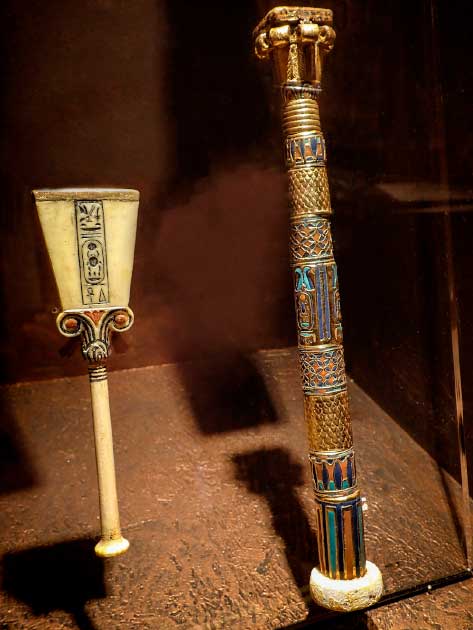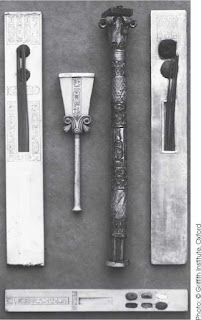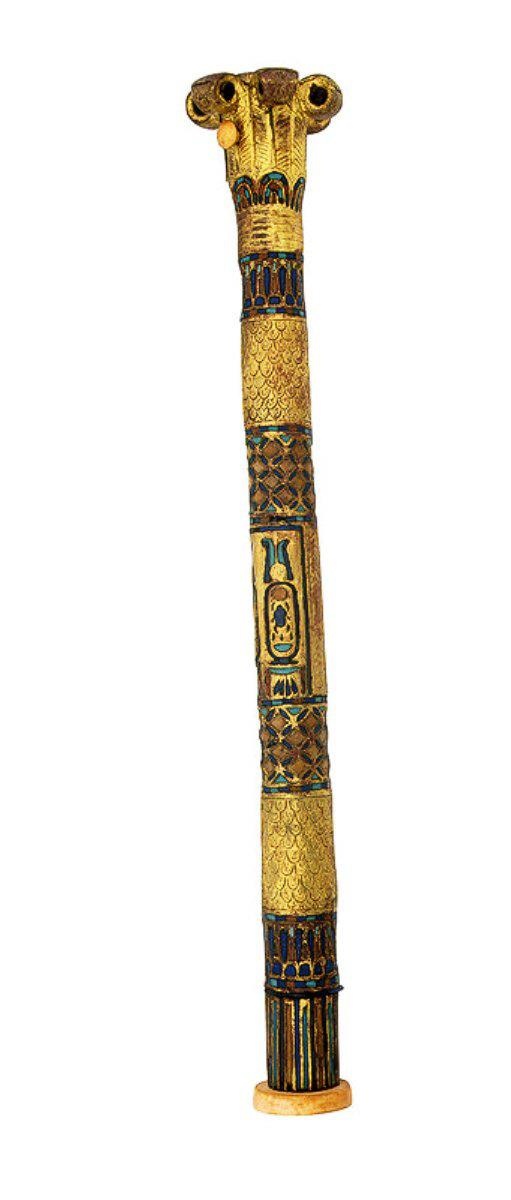The discovery of King Tutankhamun’s tomb in 1922 by British archaeologist Howard Carter remains one of the most significant archaeological events of the 20th century. The tomb, hidden deep within the Valley of the Kings, contained a wealth of treasures, offering an unprecedented glimpse into the opulent life of Egypt’s 18th Dynasty rulers. Among the most intriguing and symbolically rich artifacts discovered were two objects that stand out for their craftsmanship and cultural significance: an ivory rattle and a beautifully decorated reed pen case. These items, dating back to around 1325 BCE, provide valuable insights into the royal lifestyle, religious practices, and administrative importance of the time.
The Ivory Rattle: A Symbol of Play and Ceremony
One of the standout pieces discovered in the tomb was the ivory rattle, delicately carved and larger than life. This small yet remarkable artifact highlights the dual role of many objects in ancient Egyptian society—both as tools for daily life and as symbols in religious or ceremonial practices.

Craftsmanship and Symbolism
The ivory rattle, likely crafted from elephant tusk, showcases the incredible artistry of ancient Egyptian craftsmen. Carved with precision and elegance, it is believed to have been both a toy and a ceremonial object. In the royal court, such rattles were often used during rituals to summon divine presence or accompany music and dance. Rattles were thought to bring protection and blessings, making them highly valued in religious contexts.

The use of ivory as a material also underscores the rattle’s royal association. Ivory was a rare and costly material in ancient Egypt, typically reserved for objects of great significance, highlighting the importance of the rattle as a regal item. Whether used in religious rites or as a childhood plaything for the young Tutankhamun, this artifact adds depth to our understanding of the royal family’s daily life and ceremonial practices.
The Reed Pen Case: A Tool of Knowledge and Power
Another fascinating discovery from the tomb is the ornate reed pen case, designed to hold tools for writing on papyrus. In ancient Egypt, writing was a prestigious skill, particularly for the elite, as it was essential for record-keeping, communication, and the administration of the state.
Literacy and Bureaucracy in Ancient Egypt
The reed pen case offers a glimpse into the administrative world of ancient Egypt, where scribes played an essential role in maintaining the empire’s vast bureaucracy. The case’s intricate design reflects the high status of its owner, likely used by Tutankhamun or those in his royal court. With Egypt’s extensive system of record-keeping, the pen case is a symbol of the power of knowledge and literacy—tools used to manage and govern the kingdom effectively.

The fact that such a delicate and beautifully adorned object was intended for storing writing tools emphasizes the reverence for intellectual and administrative skills in the ancient world. Papyrus was used for everything from royal decrees to religious texts, and the storage of writing instruments in such an ornate case shows how closely intertwined knowledge, power, and prestige were in the royal court.
Cultural Significance: A Window into Egypt’s Elite
While these objects may seem small and simple, they offer a profound insight into the daily life and rituals of ancient Egypt’s elite. The ivory rattle is more than just a toy; it represents the intersection of childhood, ceremony, and spirituality. It connects the royal family with the divine, reflecting the belief that even in the afterlife, the king would be accompanied by protective forces symbolized through ritual objects.

On the other hand, the reed pen case symbolizes the importance of knowledge, governance, and administration in maintaining the empire. The decorated case reflects the Egyptian reverence for craftsmanship and their dedication to the preservation of written records, which were key to Egypt’s enduring legacy as one of the world’s most sophisticated civilizations.
Legacy and Insight into Ancient Egyptian Life
Together, the ivory rattle and reed pen case offer a rich and diverse narrative of King Tutankhamun’s reign and the world of Egypt’s elite. These items provide an intimate connection to the royal court, revealing the complex relationship between play, ceremony, and governance in one of the world’s oldest civilizations. Through these treasures, we gain a deeper understanding of the intricate rituals, the elevated status of literacy, and the exceptional craftsmanship that defined ancient Egypt.
The discovery of these artifacts also reminds us of the rich history and cultural heritage of the ancient Egyptians. As we continue to study and appreciate these remarkable objects, we draw closer to understanding the world of King Tutankhamun—one of the most famous yet mysterious rulers in ancient history. These treasures stand as enduring symbols of the wealth, wisdom, and artistry of ancient Egypt, connecting the past with the present for generations to come.

